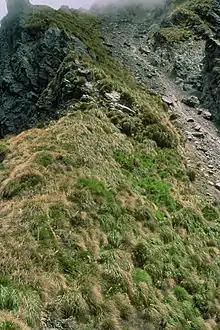Black-eyed gecko
The black-eyed gecko (Mokopirirakau kahutarae), also known commonly as Whitaker's sticky-toed gecko,[4] is a species of lizard in the family Diplodactylidae. An alpine gecko species, discovered in 1970, it inhabits high-altitude mountains in three areas of the South Island of New Zealand. It is the highest-altitude lizard species in New Zealand, living up to 2,200 m (7,200 ft) above sea level.
| Black-eyed gecko | |
|---|---|
 | |
| Scientific classification | |
| Domain: | Eukaryota |
| Kingdom: | Animalia |
| Phylum: | Chordata |
| Class: | Reptilia |
| Order: | Squamata |
| Family: | Diplodactylidae |
| Genus: | Mokopirirakau |
| Species: | M. kahutarae |
| Binomial name | |
| Mokopirirakau kahutarae (A. Whitaker, 1985) | |
| Synonyms[3] | |
| |
Description
The black-eyed gecko is a medium-sized lizard, olive or grey above and white below, with 6–7 lighter bands across the dorsal surface of its body, and speckled sides. It has very small body scales and narrow tapering toes, which more closely resemble those of an arboreal than a terrestrial gecko. It is most notable for its prominent eyebrows and unusually jet-black irises – all other related geckos have a light iris with a filigree pattern. When handled it makes chirruping calls or squeals.[5]
Behaviour
M. kahutarae is nocturnal and can be active at temperatures as low as 7°C.[5] It sun-basks on boulders at the entrance to its retreat, but is very wary and flees rapidly if disturbed.[5]
Taxonomy
Initially classified in the genus Hoplodactylus, the black-eyed gecko is now placed in the genus Mokopirirakau along with other narrow-toed alpine and forest geckos.[6] The holotype specimen is in the collection of the Museum of New Zealand Te Papa Tongarewa.[7]
Geographic range

The first specimen of M. kahutarae collected was found in March 1970 in a colony of Hutton's shearwaters on Mt Tarahaka in the Seaward Kaikōura Range. It was immediately recognised as an undescribed species, but repeated searches from 1970 to 1981 in the Seaward Kaikōuras failed to find any further individuals, until in 1983 four were collected in the Kahutara Saddle area, 30 km (19 mi) away from where it was first found. The specific epithet, kahutarae, is taken from the place where the type specimen was found.[5]
The black-eyed gecko has since been found in the mountains of Nelson and in the Lewis Pass area, living on alpine bluffs and rocky outcrops between 1,200 and 2,200 m (3,900 and 7,200 ft). It is able to survive in the sub-nival zone, where vegetation is patchy and snow-covered in winter.[8]
It is possible that this species is not especially adapted to an alpine habit; rocks and bluffs may be its last retreat from the rats and mice common at lower altitudes.[5]
Conservation status
In 2012 the Department of Conservation (DOC) classified M. kahutarae as Nationally Vulnerable under the New Zealand Threat Classification System. This was based on it existing in just a few subpopulations, the largest of less than 500 individuals, predicted to decline. It was noted as being data-poor, and sparsely distributed with a restricted range.[9]
See also
References
- Hitchmough, R.; van Winkel, D.; Lettink, M.; Chapple, D. (2019). "Mokopirirakau kahutarae". IUCN Red List of Threatened Species. 2019: e.T10251A120188625. doi:10.2305/IUCN.UK.2019-2.RLTS.T10251A120188625.en. Retrieved 14 November 2021.
- Listed by New Zealand
- "Mokopirirakau kahutarae ". The Reptile Database. www.reptile-database.org.
- Beolens, Bo; Watkins, Michael; Grayson, Michael (2011). The Eponym Dictionary of Reptiles. Baltimore: Johns Hopkins University Press. xiii + 296 pp. ISBN 978-1-4214-0135-5. ("Whitaker's Sticky-toed Gecko Hoplodactylus kahutarae Whitaker, 1985", p. 284).
- Whitaker AH (1984). "Hoplodactylus kahutarae n. sp. (Reptilia: Gekkonidae) from the Seaward Kaikoura Range, Marlborough, New Zealand". New Zealand Journal of Zoology. 11 (3): 259–270. doi:10.1080/03014223.1984.10428239.
- Nielsen, Stuart V.; Bauer, Aaron M. [in French]; Jackman, Todd R.; Hitchmough, Rod A.; Daugherty, Charles H. (2011). "New Zealand geckos (Diplodactylidae): Cryptic diversity in a post-Gondwanan lineage with trans-Tasman affinities". Molecular Phylogenetics and Evolution. 59 (1): 1–22. doi:10.1016/j.ympev.2010.12.007. ISSN 1055-7903. PMID 21184833.
- "Mokopirirakau kahutarae Whitaker, 1985; holotype". Collections Online. Museum of New Zealand Te Papa Tongarewa. Retrieved 19 July 2015.
- Jewell, Tony (2011). A Photographic Guide to Reptiles and Amphibians of New Zealand. Auckland: New Holland. p. 42. ISBN 978-1-86966-203-5.
- Hitchmough, Rod; Anderson, Peter; Barr, Ben; Monks, Jo; Lettink, Marieke; Reardon, James; Tocher, Mandy; Whitaker, Tony. "Conservation status of New Zealand reptiles, 2012" (PDF). Department of Conservation. The Government of New Zealand. Retrieved 18 July 2015.
External links
- Alpine geckos discussed on Radio NZ Critter of the Week,15 July 2016
